 |
||||||||||||||||||||||||
| Alchemist Sound bears no relation to the British Alchemist of Kraken fame. The product seems built in China, the current headquarters are in Cupertino/CA and, according to their site, the firm was founded in Silicon Valley. Frustratingly little documentation was on hand during the show. To boot, the fella manning the display didn't know much either, apparently standing in for someone else who wasn't present while I happened upon this room. However, the pricing and build quality in evidence caused a quick double-take - $3,800 for the 75-watt, 8 x KT88 push/pull SF-1 integrated amp, $3,000 for the remote-controlled, 170-watt x 7 fully loaded pre/pro/multi-channel amp. The SF-1 is said to drive ATC10 and B&W 801 speakers and uses 1 x 12AT7, 2 x 12AU7 and 2 x 5687 twin triodes for the input and driver stages. Four inputs are offered. Nothing further could be unearthed on the second piece except that all current surround-sound formats seem supported. Friendly advice to the alchemists: Seeing that you spent the money and effort to be there in the first place and brought impressive-looking products, why not insure professional representation and hand-outs? First impressions can be crucial. |
||||||||||||||||||||||||
 |
||||||||||||||||||||||||
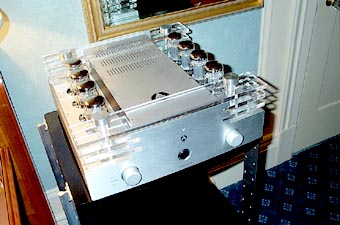 |
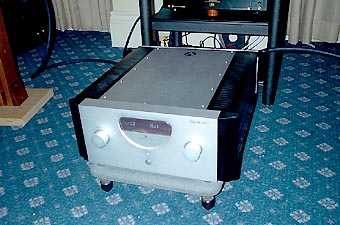 |
|||||||||||||||||||||||
Art Audio premiered the 16-watt 845 Carissa SET, $3,995 in black trim with chrome accents, $4,500 in full gleam as shown. Though capable of 28 watts in this particular circuit, designer Joe Fratus was keen on overcoming the well-known limitations of this high-power transmitter triode - a soft top, very developed but slightly out-of-control bass and a tendency for overall thickness. Experimenting extensively with custom split-core output transformers and supply voltages, he settled on lower voltage but higher current instead. The result? |
||||||||||||||||||||||||
| An amp that, leashed to the Cain & Cain BEN-SE speakers already covered, impressed with unusual treble reach, enormous heft and a quicker, less euphonic mien than most 845 designs. By comparison to the special-order-only PX-25 monos (starting at $10,500/pr), the 6 watters were faster still, more refined and transparent while the Carissa had more image density, greater cojones and a warmer personality. | 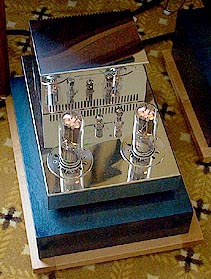 |
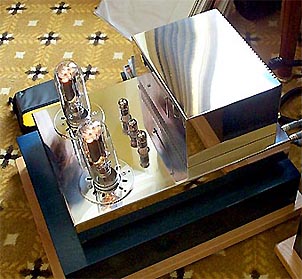 |
||||||||||||||||||||||
Based on the existing chassis of the high-power and very expensive Adagio monoblocks, Art Audio can further gussy up the Carissa's esthetics with the Adagio's external support columns and Hovland-type blue-lit glass tube chimneys. Asked about fancified cost, Joe Fratus cracked up. His concern for the Carissa had been to offer advanced single-ended sound with superior control and the kind of raw drive his far more expensive Jota is famous for. Mission accomplished. Why was I already pushing the expense of this (for Art Audio) entry-level-priced new baby upwards? Frankly, he hadn't finalized the numbers. Interested parties may inquire, however. (For reference, Adagio pix below from our CES 2003 coverage files.) |
||||||||||||||||||||||||
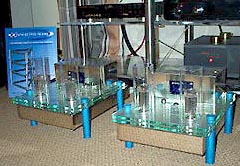 |
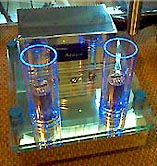 |
|||||||||||||||||||||||
| Extrapolating from the Jota and new PX-25 monos, I did what reporters chasing stories are supposed to do - be a bloody pest and nuisance. Were Carissa paralleled 845 monos in the future? Fratus wagged a warning finger and grinned. He'd already thought of that. However, the split-core output transformer required for such a high-power 845 scheme would be so monstrous as to exceed the real estate of the chosen chassis. Fair enough. | ||||||||||||||||||||||||
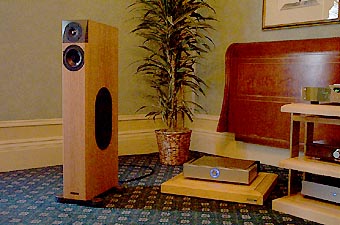 |
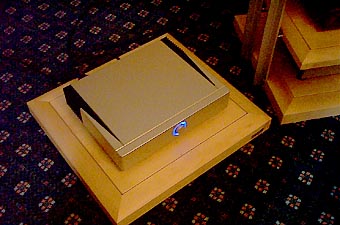 |
|||||||||||||||||||||||
| Paid attention? One particular listing in the previous mention of good-sounding digital amplifier demos should have thrown you. Audio Physic. You're looking at a 250-watt, compact-chassis, single-ended monaural device dubbed tersely the Audio Physic Mono ($24,995/pr). It employs no output filter but spread-spectrum-type, 3-6MHz sampling rates and a chaos modulator steering the voltage of the 5KiloWatt power supply. Eschewing A/D conversion, the analog input stage designed by Mircia Naiju of Siemens is an XLR/RCA instrumentation amp that combines three operational amplifiers and doesn't favor balanced connection for superior results. The overall architecture carries a German patent and offers 500/825-watt output into 4/2 ohms (equivalent to 65 volts into 2 ohms) and is merely current-limited at 1.6 ohms to protect speakers and circuit breakers. | ||||||||||||||||||||||||
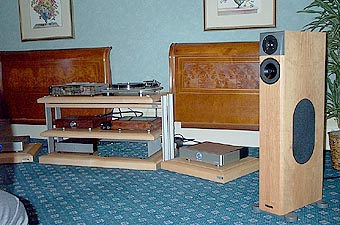 |
||||||||||||||||||||||||
A dealer friend from Santa Fe whispered that this design had been around for two years. I felt asleep behind the wheel. Where had I been? I contacted president Joachim Gerhard post-show to get the above scoopy-doo. Indeed, the design had first pioneered two years ago but undergone extensive subsequent refinements to assure predictable behavior under any and all conditions. 100 pairs are in inventory now, ready to find homes with well-heeled music lovers. Next, a few words on the new $5,494/pr Padua speaker model, filling in between the $3,995/pr Tempo and $6,995 Virgo. Set up in Audio Physic's customary long-wall, ultra wide-spaced array, the Padua's narrow two-way monitor face uses an "active cone damped" midrange transducer derived from the Avanti model and gains bass augmentation from paralleled 20cm push/push woofers on either side. They operate in electrical phase but mechanical anti-phase for vibration cancelling. They are cleverly staggered, with the left-facing woofer higher than the right, hence the oval grill cover. This allows a modicum of in-room tuning by reversing the left/right speaker and shifting tonal balance from neutral to slightly warmer. Frequency response is given as 30Hz to 33kHz response and 90dB sensitivity at its nominal 4-ohm impedance. As usual for Audio Physic demos, the speakers vanished without a trace, with exceptionally well-damped bass, holographic soundstaging and no trace of solid-state hardness. With a -3dB point of 250kHz, the Audio Physic monos are extremely fast, wide bandwidth performers without the treble phase shift penalties incurred by more restricted designs. |
||||||||||||||||||||||||
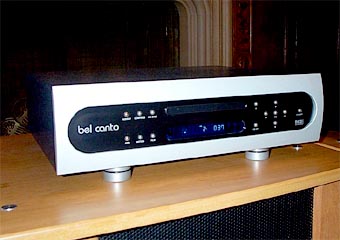 |
Fellow switchmode-rnists Bel Canto Design meanwhile held court in an absolutely massive 12th floor exhibit courtesy of -- very well-stocked -- retailer HT Electronics who enjoyed a huge presence also in adjacent rooms. Showing off with JMlab's magnificent new "ultra" Utopias in both 2- and multi-channel displays, BCD's new PLayer, first shown in prototype form at CES, made its final production debut. Truly universal, it supports CD, CD-R, DVD, DVD-A, MP3 and SACD. A front-mounted "Video Off" switch eliminates video crosstalk while playing only-audio formats. 16 regulated sections of discrete audio/video power supplies; multiple independent low-jitter clocks; 108MHz/12-bit video DACs with proprietary video filtering; 480p progressive scan; DCDi Faroudja de-interlacing circuitry; direct access of Faroudja options for component and RGB video outputs; sync on green; H/V sync; audio delay sync; adaptive motion control; multiple animation/film modes; RS-232 port; RCA, BNC, balanced AES/EBU DVD-V and CD digital outputs; an optional SDI serial digital interface; DAC-2 based 24/192 processing... studying the specs revealed a virtual who's who laundry list and suggests that nothing was left to chance when it came to providing audio- and videophiles with a full complement of all necessary options. Price of admission? | |||||||||||||||||||||||
 |
||||||||||||||||||||||||
 |
||||||||||||||||||||||||
| $8,900. Like magic, Mike McCormick's Sacred Feast - Gaudeamus [DMP SACD 09], cued up to "Ubi Caritas" concluded the cinema presentation, the soothing balm of choral music restoring Matrix'd spirits to bullett-free wholeness. | ||||||||||||||||||||||||
| After seeing buttoned-up Lexicon processors elsewhere at the show, the non-threatening, intuitively simple layout of Bel Canto's PrePro appealed very much to this relative video virgin. The less buttons the merrier - and let those that remain be labeled not with insider acronyms but "7.1 in" and "surround". That I can dig. Got to hear the big rig only in passing, due to making a meeting with the Dutch couple on the same floor and then never returning. Perhaps that was a good thing? I could otherwise be accused of undue partisanship - most know by now that I really like BCD products. Still, the Grande Utopia Beryllium deserve a closer listen. They sure looked imposing as hell. |
||||||||||||||||||||||||
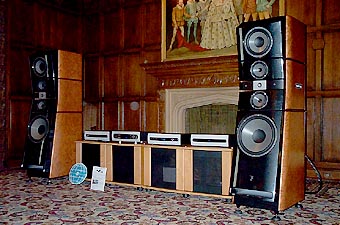 |
||||||||||||||||||||||||
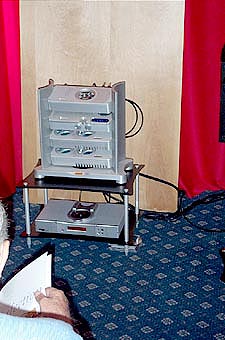 |
||||||||||||||||||||||||
Our next Chord comes sans commentary due to a drowsy driver drifting without directions. Translation? Probably because no music was playing just when I entered, no convenient salesman on hand to press for data, I spaced on taking notes. In Japanese tourist style, I merely smiled and pointed the camera. Sex sells, you say? Then Chord should be laughing all the way to the vault. |
||||||||||||||||||||||||
| With distinctive styling and finish fit for a lab, the integrated Chord stack spelled massive R rating and belongs into the home of XXX aka Vin Diesel's modern-day James Bond. The Rega planet seems outa place? Chord is hard at work on their own transport. | ||||||||||||||||||||||||
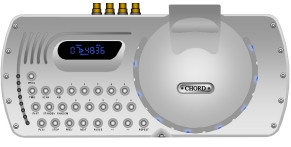 |
||||||||||||||||||||||||
| To mate with its DAC64, the CD transport will be dedicated for music while a separate DVD multi-channel transport will be optimized for the AV enthusiast. My apologies to Chord for marginal coverage. | ||||||||||||||||||||||||
 |
 |
|||||||||||||||||||||||
 |
||||||||||||||||||||||||